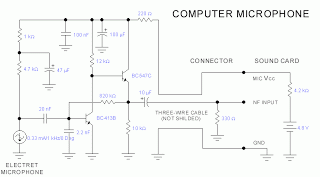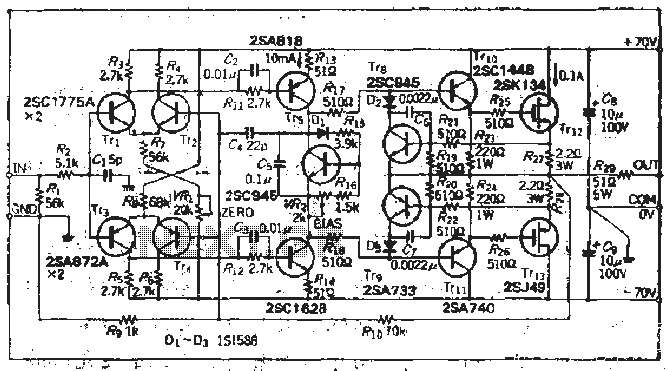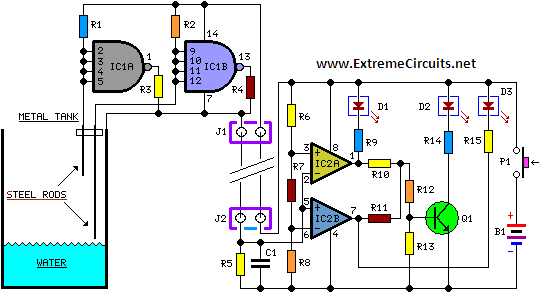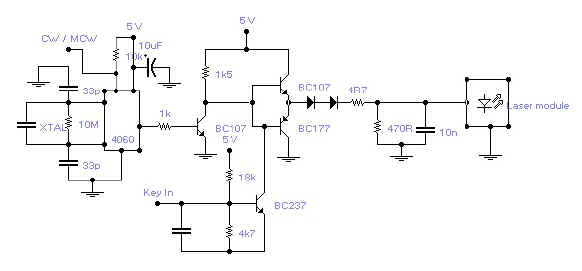
Siren Oscillator Circuit

A CD4093 chip and several components form a siren oscillator that drives power MOSFET Tl. A speaker is directly powered by this device. The siren is activated by a logic high signal applied to the ENABLE input.
The circuit comprises a CD4093 quad NAND gate configured as an oscillator. This oscillator produces a square wave output, which is then used to control a power MOSFET (Tl). The choice of the CD4093 allows for the creation of a stable oscillation due to its inherent characteristics of providing a high degree of noise immunity and a wide supply voltage range.
The components surrounding the CD4093, such as resistors and capacitors, are selected to determine the frequency and duty cycle of the oscillation. Typically, the timing components are connected to the NAND gates in such a way that they create a feedback loop, allowing the circuit to oscillate continuously. The frequency of the oscillation can be adjusted by varying the values of the resistors and capacitors in the timing network.
The power MOSFET (Tl) acts as a switch that is controlled by the output of the CD4093. When the oscillator produces a high output, the MOSFET is turned on, allowing current to flow through the connected speaker. This results in the generation of sound, which simulates a siren effect. The speaker is connected directly to the drain of the MOSFET, ensuring that it receives adequate power to produce the desired sound output.
Activation of the siren occurs when a logic high signal is applied to the ENABLE input of the circuit. This input can be connected to a microcontroller or any other digital logic circuit capable of providing a high signal. When the ENABLE input is high, it allows the oscillator to function, thereby producing the oscillating signal necessary to drive the MOSFET and, consequently, the speaker.
Overall, this circuit design is efficient and straightforward, suitable for applications requiring a simple siren sound generation with minimal components. Proper selection of the timing components and the power MOSFET ensures reliable operation and sound output. A CD4093 chip and a few components make up a siren oscillator, which drives power MOSFET Tl. 4 speaker is driven directly from this device. The siren is enabled by a logic high applied to the ENABLE input.
The circuit comprises a CD4093 quad NAND gate configured as an oscillator. This oscillator produces a square wave output, which is then used to control a power MOSFET (Tl). The choice of the CD4093 allows for the creation of a stable oscillation due to its inherent characteristics of providing a high degree of noise immunity and a wide supply voltage range.
The components surrounding the CD4093, such as resistors and capacitors, are selected to determine the frequency and duty cycle of the oscillation. Typically, the timing components are connected to the NAND gates in such a way that they create a feedback loop, allowing the circuit to oscillate continuously. The frequency of the oscillation can be adjusted by varying the values of the resistors and capacitors in the timing network.
The power MOSFET (Tl) acts as a switch that is controlled by the output of the CD4093. When the oscillator produces a high output, the MOSFET is turned on, allowing current to flow through the connected speaker. This results in the generation of sound, which simulates a siren effect. The speaker is connected directly to the drain of the MOSFET, ensuring that it receives adequate power to produce the desired sound output.
Activation of the siren occurs when a logic high signal is applied to the ENABLE input of the circuit. This input can be connected to a microcontroller or any other digital logic circuit capable of providing a high signal. When the ENABLE input is high, it allows the oscillator to function, thereby producing the oscillating signal necessary to drive the MOSFET and, consequently, the speaker.
Overall, this circuit design is efficient and straightforward, suitable for applications requiring a simple siren sound generation with minimal components. Proper selection of the timing components and the power MOSFET ensures reliable operation and sound output. A CD4093 chip and a few components make up a siren oscillator, which drives power MOSFET Tl. 4 speaker is driven directly from this device. The siren is enabled by a logic high applied to the ENABLE input.





